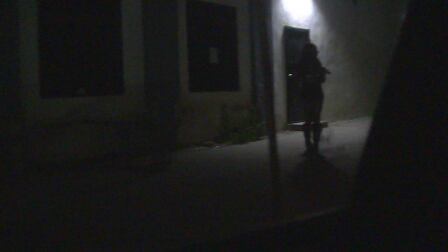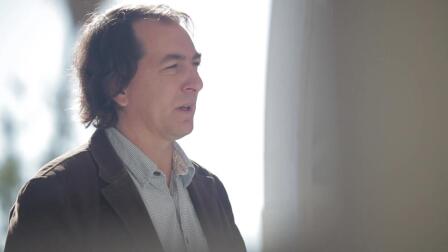A Tiny House is a Work of Art
More than 25 years in the making, artist Dominique Moody has created an exquisite tiny house on wheels. She calls it “The Nomad.”
“The Nomad” is Moody’s dream home that symbolizes her evolution as an artist and storyteller. Over her lifetime, she has lived and worked in more than 40 locations across the country. Her creation will allow her to continue her nomadic life, taking her home and her artwork to communities across the country.
“The Nomad” is made largely of repurposed materials – metal, wood, doors from washing machines. It mirrors her career as an assemblage artist who turns found objects into art.
It is even more impressive considering that Moody is losing her eyesight through macular degeneration which robs her of all but her peripheral vision. But Moody makes a distinction between “sight” and “vision," saying her limited sight has not inhibited her inner vision and imagination.
For a few days in December 2015, Moody put the home on display at the California African American Museum. The 140 square foot home is powered by solar panels and hand pumped water storage. It attracted more than a hundred visitors who were fascinated by its beauty and inspired to reduce their carbon footprint by turning to affordable, compact, and eco-friendly homes.
In this episode of SoCal Connected, reporter Nic Cha Kim tours this unique abode and gets to know the artist who created it.
Featuring Interviews With:
- Dominique Moody, artist
- Leo Thau
Transcript
Nic Cha Kim: I heard about a tiny house that was sitting in Exposition Park... but only for a few days. So I got there early to check it out. I wasn't the only one.
Dominique Moody: And so they open out. To me, they are a portal.
Nic Cha Kim: The creator of this home is an artist named Dominique Moody. She calls it Nomad and it's made out of discarded items like washer doors.
Dominique Moody: So it's a mixture of both things high tech, in things like an induction cooker but also low tech in terms of you know, hand pressure...
Nic Cha Kim: It's basically a work of art... that she lives in. Would you live in a tiny home like this?
Kid: Yes. I would collect a lot of wood and put up and make stuff out of it.
Nic Cha Kim: You know, it sounds like you're an assemblage artist already! What inspired you to build Nomad?
Dominique Moody: I started exploring the stories of my family and really going deep into this pattern of movement.
Nic Cha Kim: Movement is something Dominique says a lot. She's lived in 3 different countries, 7 states…and would you believe.. 46 different homes! Thus... the license plate.
Guest: Like a futon... your bed.
Dominique Moody: This is for both seating as well as for sleeping.
Guest: That's where you sleep.
Dominique Moody: The whole element of the Nomad is have all of my basic needs met even though it's in 140 square feet. I was born in Augsburg, Germany, military family... That set the tone for having to move about quite frequently.
Nic Cha Kim: In fact, Dominique's first memory at age four is flying across the Atlantic ocean to America.
Dominique Moody: To see the clouds below me, to see the landmass, to see the night sky was so profound that it stuck in my memory. It's always a sensory thing that kicks in whenever I move again.
Nic Cha Kim: Even from an early age, Dominique knew she wanted to become an artist but she didn't have any materials so she started making things literally out of garbage.
Dominique Moody: I loved to watch the trashmen come pick up the trash in the Philadelphia alley-ways. It was a competition between these trucks of who would be the most imaginative collection of objects.
Nic Cha Kim: So like they say... Another person's trash became Dominique's treasure. It wasn't until later she realized what she was doing was an outsider form of art called Assemblage.
Dominique Moody: I didn't know what the word meant but I knew I desired and needed this ability to express.
Nic Cha Kim: Now she's had shows around the country. It looks like a landscape to me, was that intentional?
Dominique Moody: Actually it wasn't intentional because of the scale of the panels. I had to actually create the organic line by section so I did not have the idea that I was creating a landscape...
Nic Cha Kim: You know that sort of reminds me of how you described how you actually see the world, which is peripherally...It's not obvious, but Dominique has macular degeneration. That's when the center of your vision slowly deteriorates so you can only see around the edges.
Dominique Moody: What I do is I take those fragments and as I shift and move naturally, I'm using my peripheral sight to get bits and pieces of your face and then mentally I put them together.
Nic Cha Kim: How much of me can you see?
Dominique Moody: I see parts of you. I can no longer assume someone's identity...
Nic Cha Kim: I really can't imagine what it's for an artist to lose their eye sight. It's a scary thought.
Dominique Moody: It's a fear that an artist might have, a visual artist in particular...
Nic Cha Kim: It's got to be the biggest fear.
Dominique Moody: That oh my god I'm losing my tool. What I recognized is that creativity could compensate...What I had to learn in that time period was that there was a difference between sight and vision. What an artist truly has is vision...
Nic Cha Kim: I love the different textures. I feel like, it draws me, I want to touch it.
Dominique Moody: Right. The layers of patina and color. And they have kind have melded down so they've become more natural.
Nic Cha Kim: Most artists create art in a studio. What's unique about Dominique is that she created Nomad as a work of art large enough to live in.
Dominique Moody: That was the decision, whether I should focus on a studio or build a home. And to me I felt I need to build a home and I need it to be my artwork that I am living inside of since the scale of my art was so large...This is a way for me to continue practicing my art and teaching all at the same time and living all at the same time.
Nic Cha Kim: Most people were drawn to the artistry of Nomad. As a work of art, it's beautiful. But there were others that saw something else. Who do you think could benefit from living in a tiny home like this?
Bonnie: I think everyone could benefit. I think it reminds everyone we need to reduce our carbon footprint. We need to make housing affordable and available to...
Nic Cha Kim: Would you live in a tiny home?
Bonnie: I would.
Nic Cha Kim: And now the world is your studio, is that how you look at it?
Dominique Moody: Yes. No work will be done inside. All studio practice will be done outside and then left for someone else to encounter.
Nic Cha Kim: Do you intend to live in Nomad for the rest of your life?
Dominique Moody: It is my dream home, almost literally.
Nic Cha Kim: Dominique is living her dream. With the help of some friends, Nomad is back on the road, continuing a journey where home is everywhere. I'm Nic Cha Kim, for SoCal Connected.























